Trying to decide between the 6.8 Western, 7mm Remington Magnum, and 28 Nosler cartridges? Here’s what you need to know about them.
I think most hunters would agree that the 7mm Remington Magnum and 28 Nosler are both fantastic cartridges for hunting a wide variety of big game. However, the 6.8 Western is much newer and is not nearly as well understood by the majority of sportsmen. All offer certain advantages to hunters, but there are some significant differences between the 6.8 Western vs 7mm Rem Mag vs 28 Nosler cartridges you should be aware of.
Unfortunately, as is the case with many things involving the new cartridges like the 6.8 Western, there’s a lot of misinformation and marketing hype out there regarding the capabilities of the new caliber. For this reason, it’s really easy to get confused when trying to understand the actual strengths and weaknesses of that cartridge compared to more established centerfire rifle cartridges like the 28 Nosler and 7mm Remington Magnum.
In this article, I’m going to do a detailed comparison of the 6.8 Western vs 7mm Rem Mag vs 28 Nosler in an effort to show the differences between those cartridges so you can make an informed decision on which one will work best for you.
Before we get started, I have a couple of administrative note:
Some of the links below are affiliate links. This means I will earn a small commission (at no extra cost to you) if you make a purchase. This helps support the blog and allows me to continue to create free content that’s useful to hunters like yourself. Thanks for your support.
Additionally, I recorded an entire podcast episode on this exact subject. If you’d rather listen than read, click the appropriate link below to listen to this episode on your preferred podcasting service.
6.8 Western vs 7mm Rem Mag vs 28 Nosler Podcast
Apple | Google | iHeart | Pandora | Spotify
History Of The 7mm Rem Mag, 28 Nosler, and 6.8 Western
The years following World War II in the United States were a true renaissance of civilian firearm and cartridge development. That time period saw a flood of new centerfire rifle cartridges like the .223 Remington, .243 Winchester, .280 Remington, and .308 Winchester.
That same general time period also saw the start of the modern “Magnum Era” when Winchester introduced a line of new belted magnum cartridges that utilized a modified .375 H&H case. The .458 Winchester Magnum came along first in 1956 and was quickly followed by the .264 Winchester Magnum and the .338 Winchester Magnum during the next couple of years.
All of those cartridges utilized a .375 H&H Magnum case necked down (or up, in the case of the .458 Win Mag) and shortened from 2.85″ to 2.5″ long. The designers used those shortened cases so all three cartridges would fit in a standard length rifle action (same as the .270 Winchester and .30-06 Springfield) instead of the longer magnum length action required by the original .375 Holland & Holland Magnum cartridge.
Remington took a page out of Winchester’s playbook and rolled out their own belted magnum cartridge in 1962 that was also based on the .375 H&H Magnum: the 7mm Remington Magnum.
Often referred to as the 7mm Rem Mag, 7mm RM, or 7mm Mag, the new Remington cartridge also used a necked down and shortened .375 H&H Magnum case. Instead of using .264″, .338″, .458″, and later .308″ bullets like Winchester did with their magnums, Remington loaded their new cartridge with .284″ bullets.
The .30-06 Springfield was (and remains) the standard by which most cartridges are judged. Well, the use of the larger case based on the .375 H&H along with the use of 7mm/.284″ bullets by the 7mm Remington Magnum resulted in a significant ballistic improvement over the .30-06.
Indeed, the 7mm Mag will shoot the same weight bullet faster than the .30-06.
Additionally, the smaller diameter .284″ bullets the 7mm Mag uses have a higher ballistic coefficient and more sectional density than .30 caliber bullets of the same weight used by the .30-06 Springfield.
For those reasons, typical 7mm Rem Mag loads have a flatter trajectory, more energy remaining downrange, and (all other things equal) will penetrate better than .30-06 Springfield loads using the same weight bullets.
The new 7mm Remington Magnum cartridge also fit in a standard length rifle action. And to top it all off, the 7mm Remington Magnum was rolled out at the same time as the now legendary Remington Model 700 rifle.
So, American hunters and shooters were immediately offered the chance to use a new high performance cartridge that was available in a well built, reasonably priced, and very accurate new rifle.
With all that in mind, it’s not surprising at all that the flat shooting and hard hitting 7mm Rem Mag quickly caught on with hunters and shooters in North America.
The 7mm Rem Mag remains extremely popular among hunters to this day.
It’s not the only or even the most powerful 7mm Magnum cartridge in common use though.
Indeed, the 7mm Weatherby Magnum introduced in 1944 was actually the first mass produced 7mm Magnum in the United States and numerous other 7mm Magnum cartridges have come along since the 7mm Rem Mag hit shelves in the 1960s like the 7mm Winchester Short Magnum (7mm WSM), the 7mm Remington Ultra Magnum (7mm RUM), the 7mm Remington Short Action Ultra Magnum (7mm SAUM), the 7mm Shooting Times Westerner (7mm STW).
All of those cartridges have experienced varying degrees of success, but another big 7mm cartridge really sticks out from the crowd: the 28 Nosler.
Nosler initially made a name for itself in the hunting community by developing revolutionary hunting bullets like the Nosler Partition, Nosler AccuBond, and Nosler Ballistic Tip.
Well, they dove into the cartridge development world with the introduction of the new 26 Nosler cartridge in 2013.
The name “26 Nosler” reflects both the name of the company as well as the first two digits of the cartridge bullet diameter (.264″ in the case of the 26 Nosler).
Based on a modified 404 Jeffery case necked down to shoot .264″ bullets, the 26 Nosler was definitely in the running for the title of the “world’s most powerful 6.5mm commercial cartridge.”
The 26 Nosler was a big enough success that Nosler introduced the 28 Nosler, which fires 7mm/.284″ bullets, as the next addition to their line of Nosler Proprietary Cartridges in 2015.
Like the 26 Nosler, the 28 Nosler also uses a modified 404 Jeffery case that’s necked down and shortened to fit in a standard 30-06 length action. The company decided to use a 1:9 rifling twist rate for the 28 Nosler that’s optimal for long, high BC 7mm/.284″ bullets like their 175gr AccuBond Long Range.
The result is a cartridge capable of launching those heavy for caliber and extremely aerodynamic bullets at muzzle velocities in excess of 3,100fps. The cartridge is also capable of firing lighter 140gr, 150gr, and 160gr bullets approximately 200-300fps faster than the 7mm Rem Mag.
Not surprisingly, the flat shooting and hard hitting 28 Nosler is a favorite among hunters after big game like elk that desire a cartridge that offers excellent performance at extended range.
The success of the 26 and 28 Nosler spurred the development of further Nosler cartridges. As of 2022, the lineup of Nosler cartridges now includes the 22 Nosler (.224″) introduced in 2017, the 27 Nosler (.277″) introduced in 2020, the 30 Nosler (.308″) introduced in 2016, and the 33 Nosler (.338″) introduced in 2016.
Of all those, the 28 Nosler is by far the most popular as I write this article.
Now let’s talk about the 6.8 Western. To do that, we need to go all the way back to 1925 with the introduction of the .270 Winchester though.
Designed by necking down a .30-06 case to use .277″ instead of .308″ bullets, the original .270 Winchester load shot a 130 grain bullet at approximately 3,140 feet per second (2,846 ft-lbs of energy). Originally released with the Winchester Model 54 rifle, the cartridge developed a well-deserved reputation for effectiveness on thin-skinned game over the years.
The cartridge understandably developed a large and devoted following during the course of the 20th Century and the .270 caliber became irrevocably linked to the Winchester brand.
As good as the 270 Winchester is though (and it remains extremely effective), shooters in the 21st Century lamented the relatively few choices for high BC hunting bullets available in .277″ caliber.
This is because the 270 Winchester (and the more recently developed 270 Winchester Short Magnum) uses a standard 1:10″ rifling twist rate. This twist rate worked extremely well for the bullets in the 130gr-150gr weight range the cartridge was originally developed for.
Those bullets are extremely effective for many hunting applications, but they don’t quite offer the sort of the extended performance more and more hunters and shooters are looking for these days. Shooters and hunters have started to place a much higher emphasis on long, heavy, and aerodynamic projectiles in recent years with the rise in popularity of long range shooting.
In response, the various ammunition manufacturers have worked to satisfy that demand with offerings using sleek, low drag bullets. The Nosler AccuBond Long Range, the Barnes LRX, the Hornady ELD-X, and the various Berger bullets are all great examples of extremely aerodynamic hunting projectiles that have really taken off in recent years.
Unfortunately, those slower rifling twist rates used by the .270 Winchester and 270 WSM hampered development of long, heavy, low-drag bullets in .277″ caliber.
For example, there are several different hunting bullet options available in 6.5mm, 7mm, and .30 caliber with a G1 ballistic coefficient over .600 like the 143gr ELD-X in 6.5mm (.625 BC), the 168gr VLD Hunting in 7mm (.618 BC), and the 210gr AccuBond Long Range in .30 caliber (.661 BC). Comparable bullets in .277″ caliber include the 145gr ELD-X (.536 BC), 150gr VLD Hunting (.518 BC), and the 150gr AccuBond Long Range (.591 BC).
True, hunters using custom rifles with fast enough rifling twist rates can use some of the very heavy and extremely aerodynamic 277″ caliber bullets that are available these days like the 170gr Berger Extreme Outer Limits (EOL) with a .662 BC. Those heavy bullets simply weren’t an option for hunters who don’t handload and who use factory production rifles though.
That changed in 2020 when Nosler rolled out their new 27 Nosler cartridge.
Designed from the beginning to use the new .277″ caliber 165gr AccuBond Long Range (.620 BC), 27 Nosler rifles used a faster 1:8.5″ rifling twist rate and took the performance of the .277″ caliber to the next level by allowing for the use of extremely high BC bullets in a .277″ caliber cartridge.
The Nosler cartridges are excellent performers that fire bullets with higher ballistic coefficients at very fast velocities, but they’re still fairly niche offerings and are primarily available in custom rifle builds (with a handful of exceptions). Even so, this development set things in motion for the next domino to fall.
That domino fell on 15 January 2021 when Browning and Winchester announced the release of the new 6.8 Western cartridge. Also known as the 6.8 Winchester Western, the announcement of the new round took some by surprise.
Instead of just revamping an older cartridge to use heavier bullets, designers at Winchester and Browning decided from the very beginning to build a purpose built cartridge that will handily outperform the old .270 Winchester and 270 WSM.
Basically, they wanted a new .277″ cartridge that offered magnum performance with very high BC bullets that would also fit in a short action rifle.
Here’s what Winchester’s lead engineer for the 6.8 Western, Kyle Masinelli, had to say:
We wanted to get into the untapped potential of bullets above the .264 caliber. We only wanted bullets with G1 BCs above .600 and our goal was to beat the .300 Winchester Magnum’s 180-grain AccuBond’s energy delivery at 500 yards.
To that end, they borrowed a page out of the playbook used in other successful cartridge releases like the 6.5 PRC. Similar in appearance to the 270 WSM and 6.5 PRC, the 6.8 Western has an overall length of 2.955″ and uses a beltless case that’s 2.02″ long, .535″ in diameter at the base, and has a 35 degree shoulder.
Though the 270 WSM cartridge has an overall length of 2.86″ and fits neatly into the traditional definition of a short action cartridge, the 6.8 Western exceeds those standards by a hair with a maximum cartridge overall length (COAL) of 2.955″. Even so, the 6.8 Western will feed reliably from short action AICS-pattern box magazines that are so common with modern rifles.
In addition to lengthening the COAL of the 6.8 Western, designers at Winchester moved the cartridge shoulder back slightly and decreased the case length compared to the 270 WSM. Similar to what designers at Hornady did with the 300 PRC, this resulted in a little bit more space for the bullet outside the case (also known as head height).
This facilitated the use of long, heavy-for-caliber bullets without requiring them to be seated too deeply into the case that they intrude into the powder column.
Those longer bullets also required a faster rifling twist rate for proper stabilization in flight. So, designers at Winchester and Browning designed the 6.8 Western for use in rifles with a 1:7.5″ or 1:8″ rifling twist rate (1:8″ is SAAMI standard).
The end result is a short and handy .277 caliber cartridge that delivers impressive ballistics that compare very favorably to some noted long range-cartridges.
6.8 Western, 7mm Rem Mag, & 28 Nosler Cartridge Sizes
You can see differences between the 6.8 Western, 7mm Rem Mag, and 28 Nosler in the photos below.
First, the 6.8 Western is physically quite a bit smaller than the other 2 cartridges.
The 28 Nosler and 7mm Rem Mag both have a longer overall length and use a longer case length than the 6.8 Western. The Nosler case is 2.59″ long and the 7mm Rem Mag case is 2.5″ and the 6.8 Western case is 2.02″ long.
That said, the 6.8 Western is designed to fit in a short action rifle while the other 2 cartridges require the use of a long or standard length action.
Though the 6.8 Western has a maximum cartridge overall length (COAL) of 2.955″ that exceeds the traditional definition of a short-action rifle cartridge of 2.86″ long by a hair, the cartridge will feed reliably from short action AICS-pattern box magazines that are so common with modern rifles.
While all 3 cartridges have slightly different rim diameters, they all use a larger diameter cartridge case and require a larger magnum bolt face. The 28 Nosler also has a rebated rim while the other two cartridges do not.
The 7mm Remington Magnum uses a belted case while the 6.8 Western and 28 Nosler are both beltless cases. It’s important to note that the actual case diameter of the 28 Nosler and 6.8 Western (.55″ and .555″ respectively) are both larger than the non-belted portion of the 7mm Rem Mag case (.513″).
The 7mm Remington Magnum also uses a case with a little bit more taper to it than the other 2 cartridges.
Additionally, the 7mm Remington Magnum has a 25 degree shoulder angle while the 28 Nosler and 6.8 Western each have a steeper 35 degree shoulder angle. The shoulder is also moved a little farther forward with the 28 Nosler as well.
For all those reasons, the 28 Nosler has the largest case capacity of the group. The 7mm Remington Magnum comes in 2nd and has a larger case capacity than the 6.8 Western because it’s so much longer.
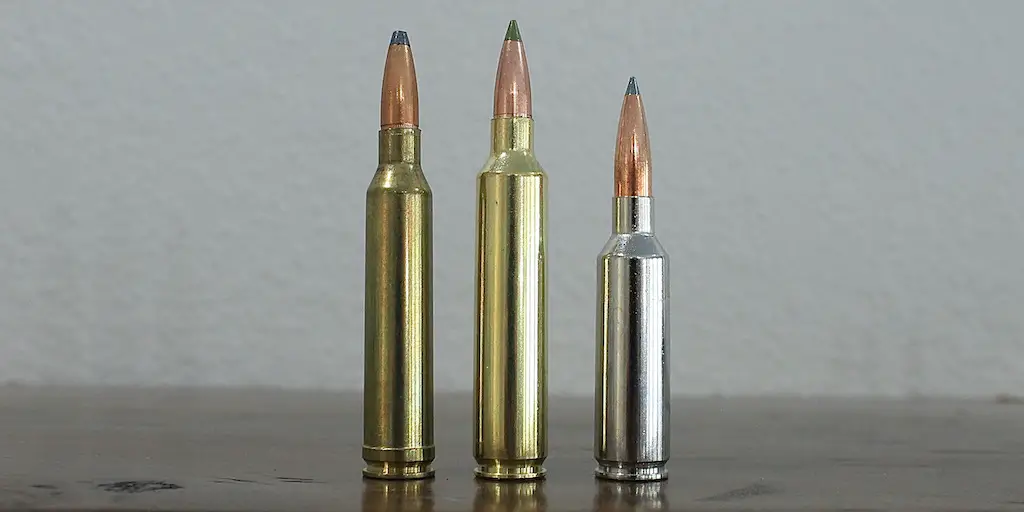
Bullet size is another one of the other important differences between the 6.8 Western vs 7mm Rem Mag vs 28 Nosler. The 6.8 Western uses .277″ diameter bullets while the 7mm Rem Mag and 28 Nosler both use .284″ bullets.
The 6.8 Western is capable of using bullets in the 130-150gr range like the 270 Winchester. However, it was designed with a faster rifling twist rate specifically for use with heavier and more aerodynamic 165gr, 170gr, and 175gr bullets, which are most common in factory loads for the cartridge.
On the other hand, the vast majority of 7mm Rem Mag factory loads shoot bullets in the 139-175 grain range. Of these, 140 grain, 150 grain, 160 grain, and 175 grain loads are by far the most common.
Finally, 28 Nosler factory loads most often use bullets in the 150-185gr range. 150gr, 155gr, 160gr, 162gr, and 175gr bullets are the most common for that cartridge.
Everything else being equal, the smaller diameter .277″ bullets have a higher ballistic coefficient and a higher sectional density than the larger diameter bullets of the same weight from 7mm cartridges. We’ll dive more into the nuts and bolts of exactly what this means in practical terms for these cartridges later in this article.
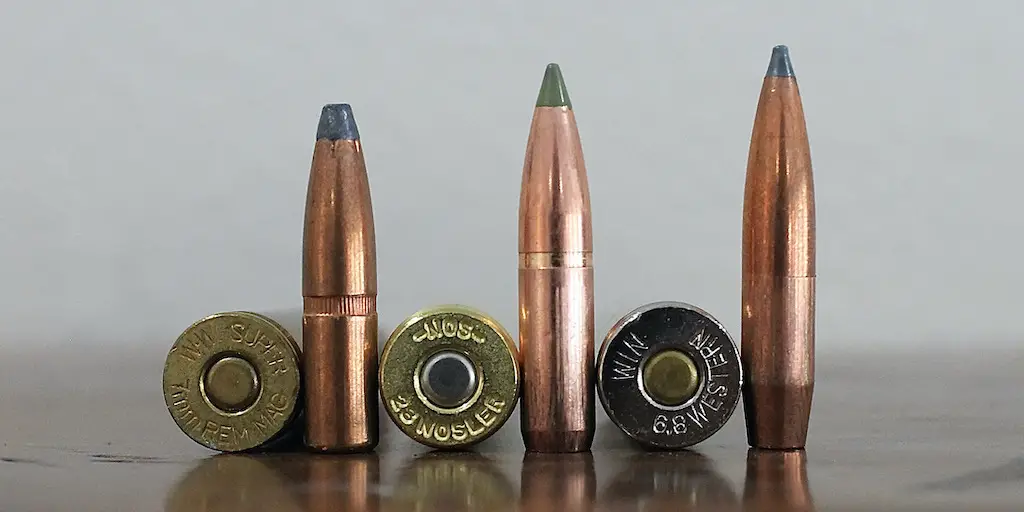
The 6.8 Western and 28 Nosler are also loaded to a higher pressure than the 7mm Rem Mag (65,000psi vs 61,000psi).
Note: while the powder capacity figures listed below do give a good indication of the differences between the two cartridges, exact case capacities vary slightly according to the brand of brass used.
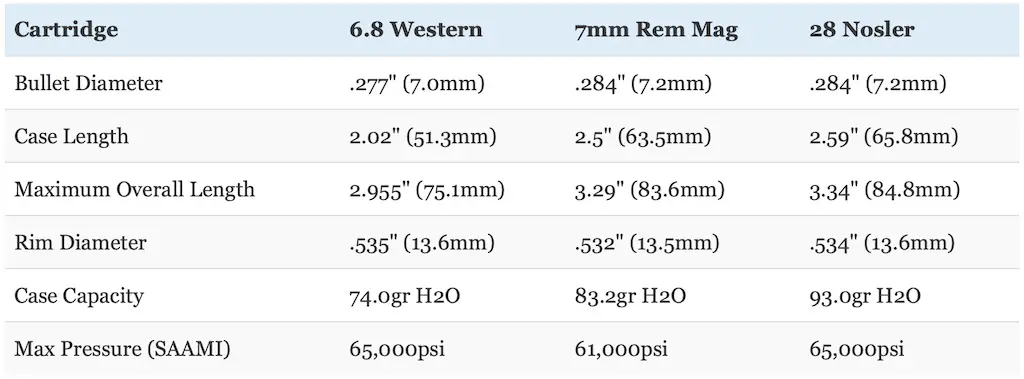
7mm Rem Mag vs 6.8 Western vs 28 Nosler Ballistics
As you can probably imagine, the differences in the external dimensions of these cartridges also translate into some important differences in their ballistic performance. This is illustrated in the table below comparing Winchester Expedition Big Game Long Range, Winchester Ballistic Silvertip, Nosler Trophy Grande Long Range, and Nosler Ballistic Tip factory ammunition.
Specifically, the 6.8 Western loads are from the Winchester Expedition Big Game Long Range and Winchester Ballistic Silvertip Line and use 165gr AccuBond Long Range (.620 BC) and 170gr Ballistic Silvertip (.563 BC) bullets.
The 7mm Rem Mag loads are from the Winchester Expedition Big Game Long Range and Nosler Ballistic Tip lines and use 168gr Nosler AccuBond Long Range (.616 BC) and 150gr Nosler Ballistic Tip (.493 BC) bullets.
The 28 Nosler loads are from the Nosler Trophy Grade Long Range and Nosler Ballistic Tip lines and use 175gr Nosler AccuBond Long Range (.648 BC) and 160gr Ballistic Tip (.531 BC) bullets.
Even though those factory loads are from two different companies, this is still an “apples to apples” comparison because all those loads all use bullets that, in practical terms, are identical. The Winchester factory loads use Nosler bullets, just with a different name and with a black Lubalox coating for the Ballistic Silvertip. They have the same BC and are otherwise identically constructed.
All six loads used a 200 yard zero.
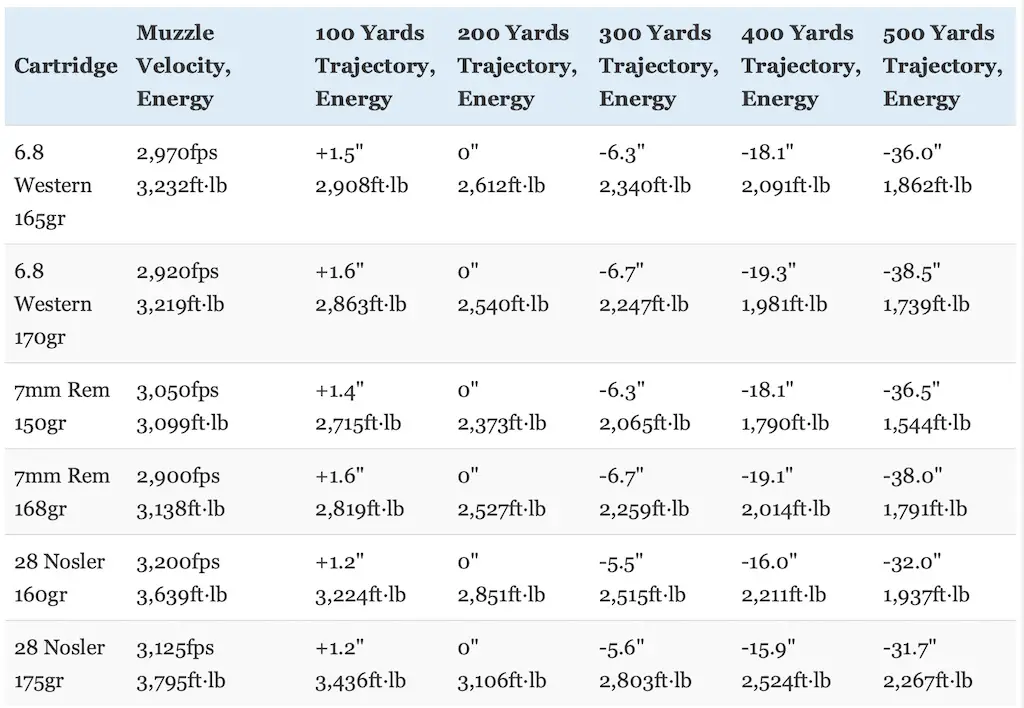
As you can see, the 6.8 Western and 7mm Remington Magnum are very close in performance. The 7mm Rem Mag Ballistic Tip load fires a lighter bullet at a faster velocity than the 6.8 Western Silvertip load, so it has a slightly flatter trajectory (just 2″ at 500 yards) but also has a bit less energy at all ranges. Since that 6.8 Western load uses a more aerodynamic bullet, that gap grows in favor of the 6.8 Western from 4% to 12% more kinetic energy at 500 yards.
The 6.8 Western has the edge with the AccuBond Long Range loads at all ranges though. The 6.8 Western fires a bullet that’s a tiny bit lighter (but just 3 grains) but also a little more aerodynamic at a slightly faster muzzle velocity.
For this reason, the 6.8 Western has a flatter trajectory and more kinetic energy at all ranges. Once again, we’re not talking about a very big difference though: the 165gr ABLR from the 6.8 Western has 2″ less bullet drop than the 168gr 7mm Rem Mag ABLR at 500 yards.
For all intents and purposes, I think it’s safe to say that the 6.8 Western and 7mm Rem Mag are practically identical in performance with those loads at these ranges.
At the same time, the fire breathing 28 Nosler surpasses both in performance with both trajectory and retained energy. Both 28 Nosler loads have between 4″ and 6.8″ less bullet drop and 4-47% more kinetic energy than the 6.8 Western and 7mm Rem Mag at 500 yards.
Look real hard at that 165gr ABLR load from the 6.8 Western again. Yes, both 28 Nosler loads definitely outperform it, but that particular 6.8 Western load stands apart from the rest of the crowd in this class of cartridges and bullets (more on this in a minute)
The chart below compares how much a 10 mile per hour crosswind impacts those same 6.8 Western, 7mm Rem Mag, and 28 Nosler loads out to 500 yards.
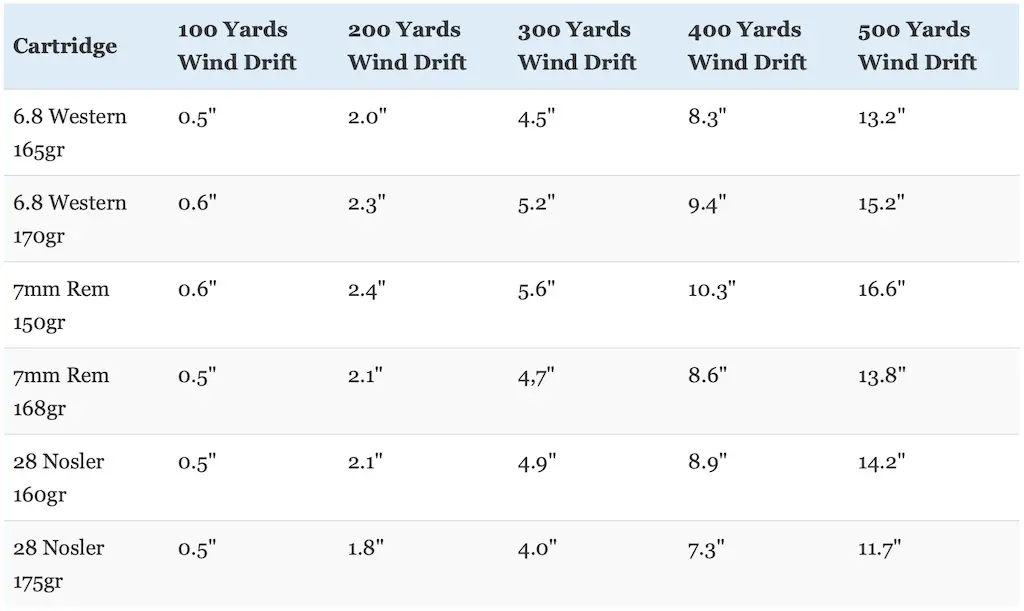
This is one of those areas where the 6.8 Western shines.
As you can see, both 6.8 Western loads offer better resistance to wind deflection than their comparable loads with the 7mm Rem Mag because they use higher BC bullets. All four loads for those two cartridges are all pretty closely matched, but with the 6.8 Western having a definite edge. Heck, that 165gr ABLR load for the 6.8 Western even outperforms the faster 28 Nosler 160gr Ballistic Tip load.
Indeed, only the 175gr ABLR load from the 28 Nosler (which is a heavier bullet weight, has a higher BC, and a faster muzzle velocity) has better performance in the wind than the 6.8 Western, but only 1.5″ less wind drift at 500 yards.
The differences are of course smaller at shorter range.
All things considered, the 28 Nosler ABLR has a small edge over the 6.8 Western, but that cartridge also has a small advantage over the 7mm Rem Mag as far as wind drift goes and.
Now let’s talk about recoil.
The table below compares the recoil produced by handloads that approximate the performance of the factory loads above firing the Nosler AccuBond Long Range for each cartridge when fired from identical 7 pound rifles.
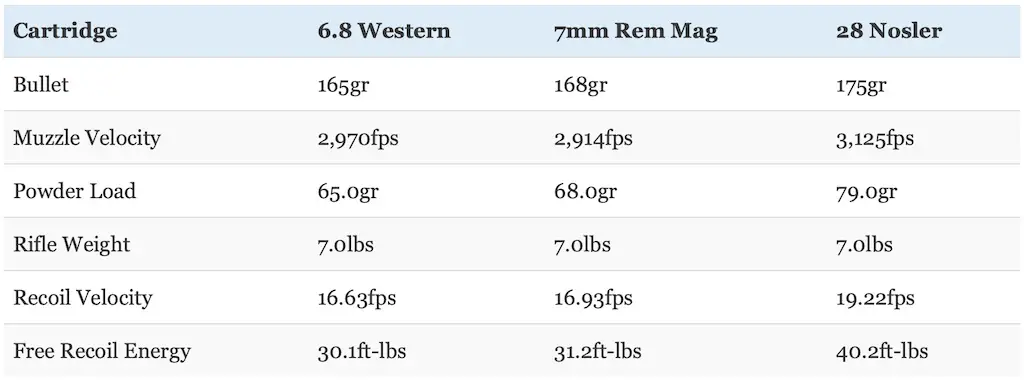
Felt recoil will vary from shooter to shooter and rifle to rifle, but free recoil energy is still a useful way to compare cartridges.
It’s true that 175gr AccuBond Long Range load looks really good on paper for the 28 Nosler. However, that performance comes at the price of a lot more recoil.
That load fires a heavier bullet at a faster velocity and uses a lot more powder to achieve that performance. The end result is that the 28 Nosler has about 33% more free recoil energy than the 6.8 Western and about 27% more free recoil energy than the 7mm Rem Mag.
It’s also worth taking note that the 6.8 Western has a little bit less recoil than the 7mm Rem Mag with these particular loads because it burns a little less powder and uses a lighter bullet.
Now, even the 28 Nosler doesn’t have a ridiculous amount of recoil. The recoil produced by this particular load is getting up there and is certainly stout, but it’s also not so excessive that it’s impossible to shoot.
This can be mitigated to a certain extent with the use of a suppressor, muzzle brake, or a good recoil pad. So the extra recoil of the 28 Nosler isn’t necessarily a deal breaker for many people. It’s still worth considering though and this is an advantage in favor of the 6.8 Western and 7mm Rem Mag.
Don’t underestimate the impact that recoil has on the ability of a person to shoot accurately either. Some people do handle recoil better than others, but all other things being equal, they will absolutely shoot more accurately with a milder recoiling cartridge.
Additionally, there are a couple of other factors that are also worth discussing.
First, the 7mm Rem Mag and 28 Nosler use larger diameter bullets than the 6.8 Western.
Specifically, the larger diameter .284″ bullets used by those 7mm cartridges have about 5% more frontal surface area (also known as cross sectional area) than the .277″ bullets used by the 6.8 Western (.0633 vs .0603 square inches). All other things being equal, a bigger bullet will make a bigger hole, cause more tissue damage, and result in more blood loss.
This is a small advantage in favor of the 7mm Rem Mag and 28 Nosler.
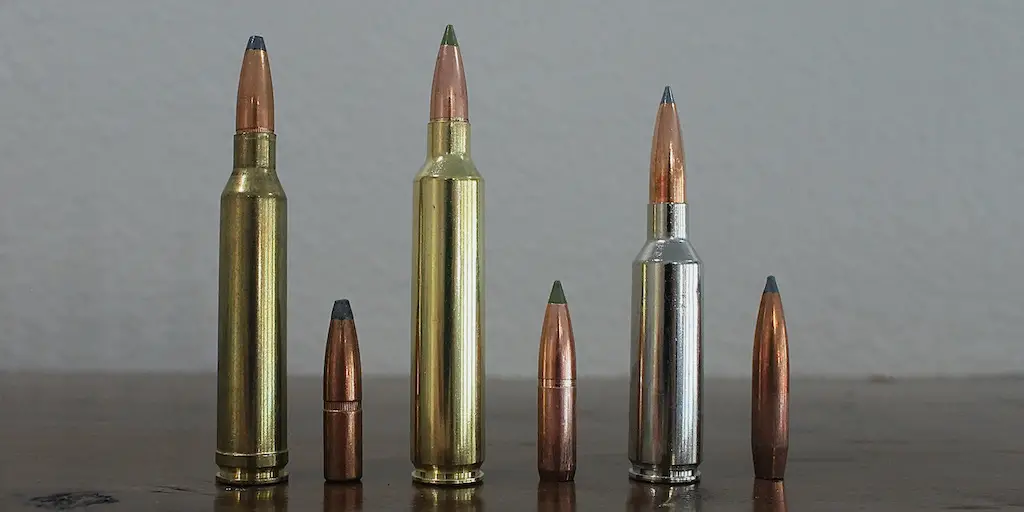
Especially when combined with the fact that the 28 Nosler carries more kinetic energy downrange, those larger diameter bullets can also be helpful when hunting big game.
On the other hand, as we covered earlier, many of those longer, heavy for caliber .277″ bullets the 6.8 Western is optimized for have a higher ballistic coefficient than the most common bullets used in the 7mm Rem Mag and 28 Nosler, especially when bullet weights are similar.
That’s not a hard and fast rule though.
For instance, the .277″ 165gr AccuBond Long Range used by the 6.8 Western has a BC of .620. This is a little higher than the .284″ 168gr AccuBond Long Range used by the 7mm Rem Mag with a BC of .616.
The 175gr AccuBond Long Range used by the 28 Nosler does have a higher BC of .648. However, it’s also 10 grains heavier and, as far as I know, that bullet is only available as a factory load with the 28 Nosler.
As another example, Nosler makes a 150gr Ballistic Tip bullet in both .277″ and .284″ with BCs of .496 and .493 respectively.
While those differences are indeed small in favor of the 6.8 Western, they are still worth considering because those slightly more aerodynamic projectiles don’t slow down as fast and are more resistant to wind drift.
They also have a relatively high sectional density (SD).
Sectional density (SD) is a measure of the ratio of the diameter of a projectile to its mass. All other things equal, a heavier projectile of a given caliber will be longer and therefore have a higher sectional density and consequently penetrate deeper than projectiles with a lower mass and sectional density.
150 grain, 165 grain, and 170 grain .277″ bullets have sectional densities of .279, .307, and .317 respectively. At the same time, 150 grain, 168 grain, and 175 grain .284″ bullets have sectional densities of .266, .298, and .310.
Nosler does offer a .284″ 185gr Nosler Reduced Drag Factor (RDF) bullet with a SD of .328. The 195gr Berger Extreme Outer Limits (EOL) bullet has a SD of .345.
While both bullets do have a higher SD than those used by the 6.8 Western, the RDF bullet is designed for target shooting and (as far as I know) the Berger EOL is only available in handloads.
So, aside from a couple of very specialized and/or target bullets in 7mm, the .277″ bullets used by the 6.8 Western have a slight edge in sectional density compared to the 7mm Rem Mag and 28 Nosler with the most commonly available hunting bullets in factory loads.
There’s nothing wrong with the killing power or penetration capabilities of either 7mm cartridge, but this is another advantage in favor of the 6.8 Western and could help the cartridge perform better on game than one might think from just looking at the ballistics of the cartridge on paper.
What about 6.8 Western vs 7mm Rem Mag vs 28 Nosler accuracy?
All three are certainly capable of outstanding accuracy (often sub-MOA) in the right hands and in good rifles.
It’s really hard to pick a winner here.
On one hand, the 28 Nosler in particular has great ballistics on paper, which can help the shooter battle environmental conditions and effectively place rounds on target.
On the other hand, the on paper ballistic performance 6.8 Western lags just a little behind the 28 Nosler, but also has substantially less recoil.
Basically, the low recoil and the ability to use heavy for caliber, high BC match grade hunting bullets work in favor for the 6.8 Western to facilitate exceptional accuracy and help maximize the shooting abilities of the hunter using the cartridge to a greater degree than the 7mm Rem Mag or 28 Nosler
In any case, the details will vary on the exact rifle, ammunition, and shooter in question. However, all three cartridges certainly have excellent potential for accuracy.
6.8 Western vs 28 Nosler vs 7mm Rem Mag Barrel Life
There can be a pretty big practical difference in 6.8 Western vs 7mm Rem Mag vs 28 Nosler barrel life.
The 28 Nosler in particular has a reputation for being rough on barrels (though not quite to the extent of the 26 Nosler). This is because the 28 Nosler uses considerably more powder than either the 6.8 Western or the 7mm Rem Mag in a similar sized space.
This means that, in general, the 28 Nosler will simply wear out barrels faster than the 7mm Rem Mag and 6.8 Western. Exactly how fast that occurs depends on a number of factors like the quality of the barrel, the exact ammunition used, etc.
For serious target shooters, this can be a concern. However, it can still potentially be an issue for hunters as well if they do not exercise care. This is especially true for those who are using the 28 Nosler at longer range where smaller changes in performance and accuracy add up quickly.
The details will vary, but it’s not unheard of for some 28 Nosler rifles to see a drop off in accuracy after just a few hundred rounds. Others will last 800-1,000 rounds, but it’s unusual to hear of them lasting much longer than that with full powered ammunition.
The good news for hunters is that typical barrel life for even the 28 Nosler is more than enough to last for many years of hunting with no issues. Exactly when the barrel is unusable depends on the rifle as well as the hunter in question and what sort of performance they expect from their rifle.
Those who want extremely tight groups for long range shooting are probably going to want to change their barrel out sooner than those with slightly lower standards.
All other things being equal, barrel life for the the 7mm Rem Mag and the 6.8 Western will be similar to each other and both will probably have a longer barrel life than the 28 Nosler.
So where do we stand with each cartridge?
6.8 Western vs 7mm Rem Mag
The 6.8 Western is capable of firing smaller diameter, but more aerodynamic bullets at a slightly faster velocity than the 7mm Rem Mag. This translates into the 6.8 Western having a slightly flatter trajectory, more resistance to wind drift, more retained kinetic energy downrange, and less recoil than the 7mm Rem Mag.
6.8 Western vs 28 Nosler
The 28 Nosler fires larger diameter, heavier, and sometimes more aerodynamic bullets at a significantly faster velocity than the 6.8 Western. Most 28 Nosler loads will recoil more than most 6.8 Western loads, but will also have more retained kinetic energy, a flatter trajectory, and more resistance to wind drift. However, some 6.8 Western loads meet or even exceed the performance of certain 28 Nosler loads in terms of bullet drop and wind drift.
7mm Rem Mag vs 28 Nosler
Both cartridges fire the same diameter bullets, but the 28 Nosler is capable of firing heavier and more aerodynamic bullets at a significantly faster velocity than the 7mm Rem Mag. For this reason, the 28 Nosler has more recoil, but retains more energy at longer range, has more resistance to wind drift, and has a flatter trajectory.
7mm Rem Mag vs 6.8 Western vs 28 Nosler Ammo
The 7mm Remington Magnum in particular is an extremely popular centerfire rifle cartridge. None are exactly rare, but of these 3 cartridges, the 7mm Rem Mag is by far the most widely used.
For that reason (during normal times) ammo is usually easiest to find for the 7mm Rem Mag. In general, 7mm Rem Mag ammo is typically the least expensive of the 3 as well.
The big ammunition manufacturers like Barnes, Berger, Browning, Federal Premium, Hornady, HSM, Nosler, Remington, Sierra, Sig Sauer, Swift, and Winchester all produce an incredible variety of ammo for the 7mm Remington Magnum in most of their really popular lines of ammo.
This includes almost everything from “plain Jane” ammo like the Remington Core Lokt and Winchester Super X lines to more specialized ammo like the Hornady Precision Hunter and Federal Terminal Ascent Lines.
The fact that 28 Nosler is a more niche cartridge is reflected with the ammo choices for it.
As of early 2022, 28 Nosler ammo is available in the Federal Terminal Ascent line loaded with a 155gr Terminal Ascent bullet, the Hornady Precision Hunter line loaded with 162gr ELD-X bullet, the Nosler Trophy Grade line loaded with a 160gr AccuBond Bullet, the Nosler E-Tip line loaded with a 150gr E-Tip bullet, and the Nosler Trophy Grade Long Range line loaded with a 175gr AccuBond Long Range bullet.
At this instant, the Winchester Expedition Big Game Long Range line loaded with 165gr Nosler AccuBond Long Range bullets, the Browning Long Range Pro Hunter line loaded with 175gr Sierra GameChanger bullets, the Winchester Ballistic SilverTip line loaded with 170gr Ballistic SilverTip bullets, and the Winchester Copper Impact line loaded with 162gr Copper Impact bullets are the only loaded ammo options I’m aware of for the 6.8 Western cartridge.
There is a surprisingly good selection of factory loaded 6.8 Western ammunition these days. At this time, Browning and Winchester are the primary sources of factory 6.8 ammo, but it’s usually not too hard to find ammo for the cartridge as of early 2022.
Ammo availability is also usually excellent online and the bigger retailers typically have a good selection of quality factory ammo for both cartridges as well.
BUY SOME GREAT 6.8 WESTERN AMMO HERE
BUY SOME GREAT 7mm REM MAG AMMO HERE
BUY SOME EXCELLENT 28 NOSLER AMMO HERE
If you’d like to learn more about some of the various hunting ammunition choices for the 6.8 Western, 7mm Rem Mag, and 28 Nosler cartridges, read these articles:
Best 6.8 Western Ammo For Hunting Elk, Deer, & Bear
Best 7mm Rem Mag Ammo For Hunting Elk & Deer
Best 28 Nosler Ammo For Hunting Elk & Deer
Handloaders will appreciate the fact that reloading components for all 3 cartridges available and there’s an pretty good variety of bullet choices for each cartridge (especially the 7mm Rem Mag and 28 Nosler). So, you should not have any trouble working up a good custom load for either one if you like to handload.
The 28 Nosler and 7mm Rem Mag both shoot the same .284″ bullet size that’s also used by the 7mm-08 Remington, 7mm Mauser, 280 Ackley Improved, 7mm STW, 7mm WSM, and 7mm SAUM (among others).
The 6.8 Western uses the same .277″ bullet size as the .270 Winchester, the 270 WSM, the 6.8 Remington SPC, and the 270 Weatherby. While those Winchester and Weatherby cartridges in particular use a slower rifling twist rate than the 6.8 Western, the 6.8 Western cartridge will readily shoot those lighter 130-150gr bullets most commonly used in those chamberings without issue.
Bullets like the Barnes LRX, TSX, and TTSX, the Berger VLD and Hybrid Hunter, the Hornady ELD-X, GMX, InterBond, InterLock, SST, and V-Max, the Nosler AccuBond, Ballistic Tip, E-Tip, and Partition, the Sierra GameChanger and GameKing, the Swift Scirocco and A-Frame, (just to name a few) are options for if you want to reload the 7mm Remington Magnum, the 28 Nosler, and the 6.8 Western.

6.8 Western vs 28 Nosler vs 7mm Rem Mag Rifles
The rifle situation with the 6.8 Western, 28 Nosler, and 7mm Remington Magnum is similar to the ammunition situation.
Of the 3, the 7mm Remington Magnum is the most popular, followed by the 28 Nosler, and then the 6.8 Western.
The 7mm Remington Magnum is available in several different versions of the Remington Model 700 and Winchester Model 70. The same goes for the Browning X-Bolt, Browning AB3, Christensen Arms Ridgeline, Kimber Hunter, Mossberg Patriot, Ruger Hawkeye, Savage Axis, Savage 110, Tikka T3 and Tikka T3x, Weatherby Vanguard, and Winchester XPR.
Basically, almost every popular centerfire rifle in current production is available in 7mm Remington Magnum.
Things are a little different with the 28 Nosler though, which is primarily available in higher end rifles that are best able to take advantage of the long range performance characteristics of the cartridge.
The 28 Nosler is available in rifles like the Christensen Arms Mesa, Ridgeline, and ELR rifle, several different versions of the Browning X-Bolt, several different rifles from Bergara, from Gunwerks, and from Seekins Precision.
Of course, Nosler also offers the 28 Nosler in their M48 rifle and their new M21 rifles.
At this time, Browning and Winchester are the only major manufacturers producing rifles in 6.8 Western.
However, there’s a pretty good selection of 6.8 Western rifles available from both companies. As of early 2022, 6.8 Western rifles include 21 different versions of the Browning X-Bolt, 14 versions of the Winchester XPR, and 9 versions of the Winchester Model 70 bolt action rifles.
During normal times, the 7mm Remington Magnum is by far the most common and easiest to find. The same goes with finding 7mm Rem Mag rifles that are less expensive.
However, as of early 2022, we’re still not living in normal times.
The 6.8 Western was first released during the middle of the big ammo shortage in early 2021, which actually meant that rifles in that chambering were fairly easy to come by until the last couple months of the year.
Most of those examples were snapped up by November or December though.
As I write this article in January of 2022, 7mm Remington Magnum rifles are the most common on dealer’s shelves, followed by the 28 Nosler.
It’s also important to realize that gun manufacturers tend to put longer barrels on rifles chambered in magnum cartridges in general. This is because those cartridges need a longer barrel to effectively and efficiently burn that larger powder charge.
This holds true for all 3 cartridges, but especially the 7mm Remington Magnum and the 28 Nosler.
Barrel lengths do vary depending on the manufacturer and exact model.
However, the 6.8 Western is normally available in rifles with a 24″ barrel, though some models have 26″ barrels. A handful of models have shorter 22″, 20″ or even 16.5″ barrels in some cases (though those shorter barrels are somewhat unusual and are most common on “suppressor ready” models).
24″ and even 26″ barrels are pretty standard with the 7mm Remington Magnum.
The same goes for the 28 Nosler, which is most common in rifles with a 26″ barrel.
All things considered, rifles chambered in 7mm Rem Mag and 28 Nosler tend to be slightly longer, heavier, and more unwieldy than rifles chambered in 6.8 Western.
Having a shorter and lighter rifle is more important on some hunts than on others. So, just keep that in mind.
BUY A GREAT 6.8 WESTERN RIFLE HERE
BUY A GREAT 7mm REM MAG RIFLE HERE
BUY A NICE 28 NOSLER RIFLE HERE
If you’d like to learn more about some of the various hunting rifle choices for the 6.8 Western cartridge, read this article:
Best 6.8 Western Hunting Rifles
6.8 Western vs 7mm Rem Mag vs 28 Nosler: Which Is Right For You?
Do you primarily hunt medium sized game like whitetail deer, feral hogs, or black bear at ranges within 200 yards? All three are extremely effective deer hunting cartridges and will absolutely get the job done on medium sized game if you do your part. There’s nothing wrong with using any of those cartridges on deer inside of 200 yards, but all three are really more gun than you need for that sort of work though. The 28 Nosler in particular will be harder on both your shoulder and your wallet than the other two as well.
If you’re going to be hunting in thick brush or in the tight confines of a deer stand, remember what I just mentioned about the size difference with 6.8 Western vs 7mm Rem Mag vs 28 Nosler rifles. That extra couple of inches in overall length of a rifle can be a real headache to deal with when trying to quickly and quietly maneuver for a shot. None are really good options for a truly compact rifle, but the 6.8 Western or 7mm Rem Mag with a 24″ barrel will be a little easier to handle than a rifle with a 26″ barrel.
Are you looking for the cartridge better suited for long range hunting for game like mule deer or pronghorn antelope in open country where you might need to take a shot at several hundred yards? Once again, they’ll all work really well in this role and situations like these are where they start to stand apart from other cartridges. The 28 Nosler carries more energy out to extended range than the other 2 cartridges, but the 6.8 Western and 7mm Rem Mag are both extremely effective in this role as well and both still carry more than 1,500 ft-lbs of energy out to 500 yards.
Do you want a hunting cartridge that’s well suited for caribou, moose, elk, eland, kudu, or red stag hunting? All work extremely well when used on bigger game. The 28 Nosler is the clear winner for a hunter looking for a really good cartridge for use on bigger game at extended range, but once again, the 6.8 Western and 7mm Rem Mag are no slouches either. Most hunters do not need the capabilities of the 28 Nosler and something like the 7mm Rem Mag will work great for the majority of elk hunting situations.
In fact, the 6.8 Western edges the 7mm Rem Mag out in energy, trajectory, wind drift, and even recoil with certain loadings, making it an outstanding choice. The 28 Nosler with that 175gr AccuBond Long Range load is still the way to go for those who want the most power, the flattest trajectory, and the most resistance to wind at extended range.
Are you specifically hunting brown or grizzly bear? What if you hunt in Canada or Alaska and need a heavy hitting cartridge just in case you find yourself on the wrong end of a grizzly/brown bear attack? I do not recommend any of these cartridges for actually hunting the big bears, though they will work in a pinch. While I’d prefer to carry something heavier like a .300 Win Mag or a .338 Win Mag in grizzly country, I’d go with the 7mm Rem Mag or the 28 Nosler over the 6.8 Western since it uses larger diameter and heavier bullets. Make sure you use premium, heavy for caliber 175gr bullets if you go that route.
Are you sensitive to recoil and in need of a serious low recoil cartridge? All three cartridges have fairly stout recoil, but the 6.8 Western and the 7mm Rem Mag are definitely better lower recoiling options than the 28 Nosler, with the 6.8 Western probably edging the 7mm Rem Mag out a bit in this area.
The 6.8 Western, 7mm Rem Mag, and 28 Nosler are all excellent rifle cartridges. While the 6.8 Western is the latest flavor of the week and does offer certain advantages over the 7mm Rem Mag in some aspects, there’s still not a darn thing wrong with the 7mm Rem Mag either. Likewise, while the 28 Nosler has very clear advantages over the other two cartridges on paper, few hunters really need the extra capability offered by the cartridge.
Though the differences between them (6.8 Western vs 7mm Rem Mag vs 28 Nosler) are fairly significant in certain respects, they’re all suitable for many hunting tasks.
So, carefully analyze your potential needs before making a decision. In the end, a lot of this decision comes down to personal preference. So, choose the one that you feel most comfortable with and it will probably serve you well afield. Good luck!
NEXT: 308 vs 30-06 SPRINGFIELD vs 300 WIN MAG: WHICH SHOULD YOU HUNT WITH?
NEXT: 101 BEST GIFTS FOR HUNTERS
Enjoy this article comparing the 6.8 Western, 7mm Remington Magnum, and 28 Nosler cartridges? Please share it with your friends on Facebook and Twitter.
The Lyman 50th Edition (p214-216 and p223-224) and Hornady 10th Edition (p406-411) reloading manuals were used as references for the history of the cartridges. I obtained the data used to compare the trajectory of the cartridges from Nosler (here, here, here, and here), and Winchester (here and here). Data used to calculate recoil was obtained from the Nosler 9th edition reloading manual (p416-423 & p443-450). Case capacity information for the 6.8 Western, 7mm Rem Mag, and 28 Nosler was obtained from Chuck Hawks, The American Rifleman, and Nosler. Maximum pressure and data to compare cartridge sizes for the 6.8 Western, 7mm Rem Mag, and 28 Nosler were obtained from SAAMI (p23, 28, p44, and p87) and here. I used ShootersCalculator.com to compare trajectory and recoil for the cartridges.
Make sure you subscribe to The Big Game Hunting Podcast and follow The Big Game Hunting Blog on Facebook, Instagram, Twitter, and YouTube.
John McAdams is a proficient blogger, experienced shooter, and long time hunter who has pursued big game in 8 different countries on 3 separate continents. John graduated from the United States Military Academy at West Point and is a veteran of combat tours with the US Army in Iraq & Afghanistan. In addition to founding and writing for The Big Game Hunting Blog, John has written for outdoor publications like Bear Hunting Magazine, The Texas State Rifle Association newsletter, Texas Wildlife Magazine, & Wide Open Spaces. Learn more about John here, read some of John’s most popular articles, and be sure to subscribe to his show: the Big Game Hunting Podcast.

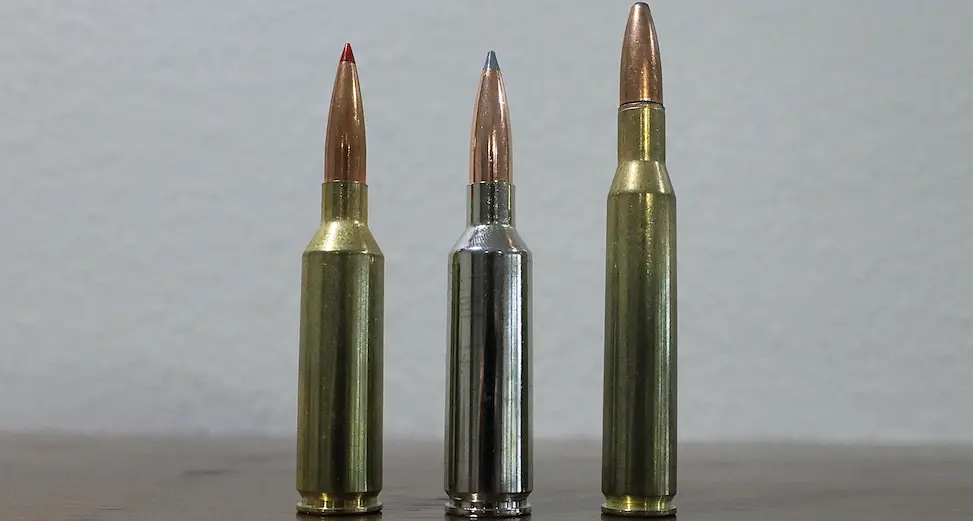


On a technical editing issue; you should rearrange the captions and the text to agree with the photo in order. e.g. in the first figure, you should change the caption to “7mm Rem Mag vs 28 Nosler vs 6.8 Western Review & Comparison.” and change it throughout the text. Unless you know what the cartridges look like it gets confusing when comparing the text with the picture. I’m looking for a 7mm Rem Mag replacement (non-belted) and these are still relatively new cartridges for me so any help in clarification helps.